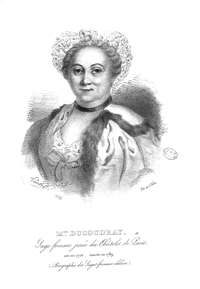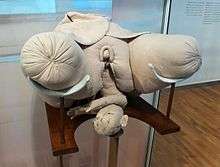Angélique du Coudray

Angélique Marguerite Le Boursier du Coudray (c. 1712 – 17 April 1794) was an influential, pioneering midwife during her lifetime, who gained fame when men were taking over the field.[1] She rose from middle-class origins to become noticed and commissioned by King Louis XV himself.[2]
Life
Angélique Marguerite Le Boursier du Coudray was born into an eminent French medical family in Clermont-Ferrand. In February 1740, at the age of twenty-five, Angélique du Coudray completed her three-year apprenticeship with Anne Bairsin, Dame Philibet Magin, and passed her qualifying examinations at the College of Surgery École de Chirurgie.[2] Within the next few years, the school of surgery had barred female midwives from receiving instruction. After Du Coudray demanded that the Faculty of Medicine of the University of Paris provide instructions to all midwives and midwifery students by signing a petition, she was accepted into the school.[2]
In 1743, the status of surgeons was raised and extended into the field of midwifery. This allowed surgeons to deny instruction to female midwives. Du Coudray and other female midwives signed a second petition and accused surgeons of neglecting their duties. She argued that by refusing to instruct female midwives, surgeons were allowing midwives to be improperly trained and so causing a shortage of officially accredited midwives. To prevent potential harm to patients, medical doctors were evoked to solve the problem.[2] After the situation was solved and all midwives received proper training, Du Coudray became the head accoucheuse at the Hôtel Dieu in Paris.[3][4] By guiding and leading in this political matter, she became a prominent figure in Paris.[5]
In 1759, she published an early midwifery textbook, Abrégé de l'art des accouchements (Abridgment of the Art of Delivery), which was a revision and expansion of an earlier midwifery textbook published in 1667.[2][4]
In the same year, the king commissioned her to teach midwifery to peasant women in an attempt to reduce infant mortality. Between 1760 and 1783, she traveled all over rural France, sharing her extensive knowledge with poor women. During this period, she is estimated to have taught in over forty French cities and rural towns and to have trained 4,000 students directly.[6] She was also responsible for the training of 6,000 other women, who were taught directly by her former students.[4] In addition, she taught about 500 surgeons and physicians, all of them men.[7] Through this educational effort Du Coudray became a national sensation and international symbol of French medical advancement.[2]
Angélique du Coudray died in Bordeaux on April 17, 1794.[2] There is mystery around her death, as it occurred during the Reign of Terror that succeeded the French Revolution. Many scholars believe she was killed during the night because she was previously been commissioned and endorsed by King Louis XV. Others argue that she simply died of old age.[2]
The Machine

Du Coudray invented the first lifesize obstetrical mannequin, for practicing mock births. It was usually called "The Machine." Each cost about 300 livres to construct, usually out of fabric, leather, and stuffing, and occasionally including actual human bones to form the torso. Various strings and straps serve to simulate the stretching of the birth canal and perineum to demonstrate the process of childbirth. The head of the infant mannequin has a shaped nose, stitched ears, hair drawn with ink, and an open mouth (with tongue) into which a finger can be inserted to a depth of 5 centimetres (2.0 in).[lower-alpha 1] This detail was important, as it allowed the midwife to put two fingers into the mouth, to facilitate the passage of the head in a case of breech presentation. These mannequins were very detailed and accurate.[8] The invention is often attributed to a Scotsman, William Smellie, but the French Academy of Surgeons approved du Coudray's model in 1758, giving her a prior claim on the invention.
Travels
Du Coudray first traveled to Moulins in November 1761 from Claremont France. Le Nain, who had heard and learned a lot about du Coudray's childbirth courses in an exchange with letters with Ballainvilliers, was extremely excited about her arrival. He was one of the first people to secure her services in his city. In her first lesson in Moulins, eighty students appeared and the second lesson brought seventy. Fewer students came because this was also harvest time and many women could not be spared from their farm duties. Du Coudray noted how many women had no aptitude and even sent them home, and only a few women really stood out to her. Her course cost the women 36–40 livres, which included the final certificate of completion. She worked her students hard and taught them just the basics, but even this was enough for them to be extremely useful in their cities. Classes took place six days a week, all morning and all afternoon, and lasted around two months, so that every student had plenty of time to listen to lectures and practice each maneuver several times on the machine. Occasionally she would allow her best students to attend live births with her supervision. In most cities she was paid 300 livres a month of her teaching.[5]
Throughout the next year and a half she traveled to Burgundy: to Autun in 1761, Bourg-en-Bresse and Chalone-sur-Saȏne in 1763, and in the same year to Limognes-en-Quercy and Tulle. She then traveled to Angoulȇme in 1764 and Bourdeilles in the same year, then to Poitiers in 1764–65, to Sablés-sur-Sarthe in 1765, and finally to Périgueux and Agen in 1769. Similar experiences took place in all these regions of the country.[9] As Du Coudray taught midwives, she instructed them to eliminate the practice of removing near-dead infants from the womb and leaving them to die without any attempt to revive them.[5]
The Abrégé
The Abrégé de l'art des accouchements contains du Coudray's lectures in the order that she taught them, starting with the female reproductive organs and the process of reproduction. It then explains the issue of proper prenatal care. Finally, it discusses how to deliver infants, including how to handle common obstetric problems. The Abrégé also covers rare cases that occurred during the birth process, which Du Coudray notes as her "observations". Throughout the book, she refers to her "machine" as a way to explain concepts. Despite its important contributions to the field of midwifery, the Abrégé was neglected when it was initially published, because it was a small, light, unobtrusive volume. Still, the existence of the book served as an influential model for midwives during the eighteenth century.[5]
See also
- Louyse Bourgeois, ancestor, midwife to Marie de' Medici.[10]
Notes
References
- ↑ Cody 2001.
- 1 2 3 4 5 6 7 8 Gelbart 1998, pp. 61-62,271.
- ↑ Stanley 1995.
- 1 2 3 Commire 1999.
- 1 2 3 4 Halff 2014.
- ↑ Fissell 2004.
- ↑ Lindemann 2010.
- ↑ Gelbart 1998, pp. 61-62.
- ↑ Gelbart 1998, p. 271.
- ↑ Encyclopedia of World Biography 2005.
Sources
- Cody, Lisa Forman (2001). "Sex, Civility, and the Self: du Coudray, d'Eon, and Eighteenth-Century Conceptions of Gendered, National, and Psychological Identity". French Historical Studies. Project MUSE. 24 (3): 379–407. doi:10.1215/00161071-24-3-379.
- Commire, Anne, ed. (1999). "Du Coudray, Angelique". Women in World History: A Biographical Encyclopedia. 4. Detroit: Yorkin Publications. p. 804. (Registration required (help)).
- Fissell, Mary E. (2004). "Obstetrics and Gynecology from Europe, 1450 to 1789". In Dewald, Jonathan. Encyclopedia of the Early Modern World. 4. New York: Charles Scribner's Sons. pp. 305–308. (Registration required (help)).
- Gelbart, Nina Rattner (1998). The King's Midwife : A History and Mystery of Madame du Coudray. Berkeley: University of California Press. ISBN 978-0520221574.
- Halff, Rebecca (20 May 2014) [1769]. "Angelique Marguerite Le Boursier du Coudray's Abrégé de l'art des accouchements". The New York Academy of Medicine (NYAM History Med): Books, Health, and History.
- Lindemann, Mary (2010). Medicine and Society in Early Modern Europe. CUP. p. 126. ISBN 978-0521732567.
- Stanley, Autumn (1995). Mothers and Daughters of Invention: Notes for a Revised History of Technology. Rutgers University Press. p. 234. ISBN 978-0813521978.
- "Bourgeois, Louyse". Encyclopedia of World Biography. Encyclopedia.com. 2005. Retrieved 28 November 2015.
External links

- Artefacts related to du Coudray at the Museum of France On line Archive. Retrieved March 2012
- Biographie d'Angélique du Coudray at the Wayback Machine (archived July 25, 2015), Jean-Yves Gourdol, Medarus
- Musée du CHU de Rouen Centre Hospitalier Universitaire (CNU Hospital), Rouen, France
- Angélique du Coudray at the Dinner Party database, Brooklyn Museum. Retrieved October 24, 2007